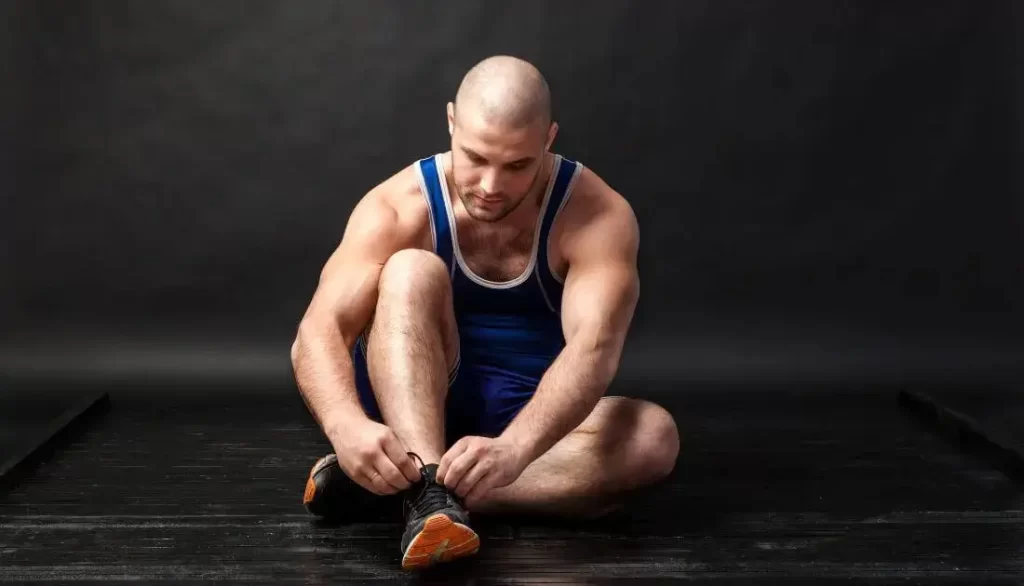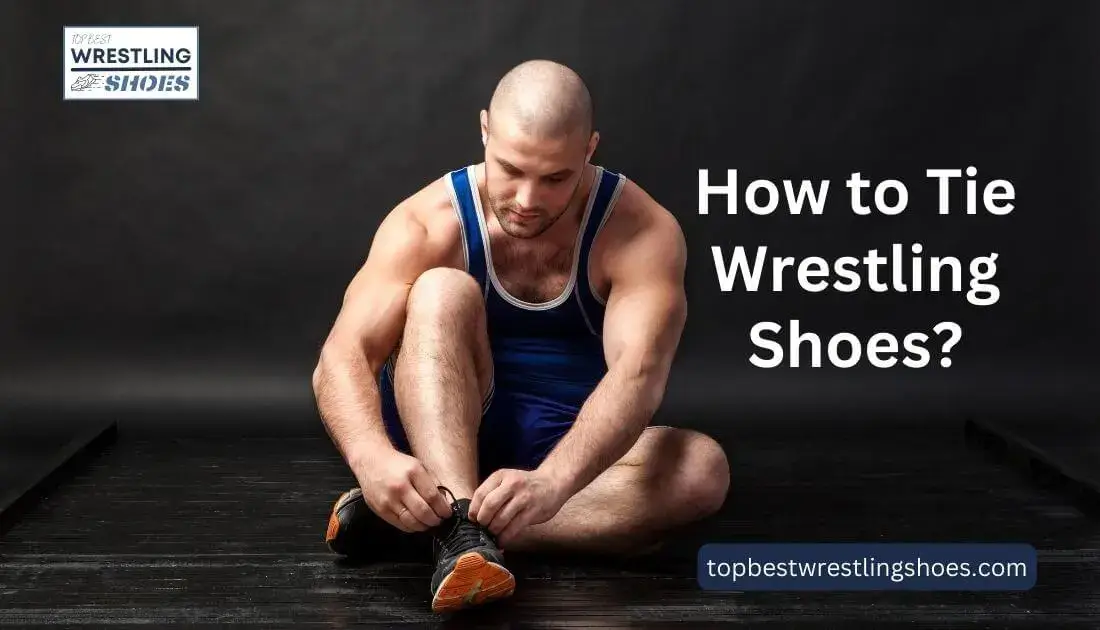How to Tie Wrestling Shoes for a Secure and Comfortable Fit?
In the fast-paced world of wrestling, every advantage counts. One of the most important factors that can affect your performance is the way you tie your best wrestling shoes.
Properly tying your wrestling shoes provides stability, support, and prevents unnecessary distractions during intense matches. It ensures your feet remain secure, allowing you to move with agility and confidence on the mat.
Whether you’re a beginner or a seasoned wrestler, mastering the art of tying your wrestling shoes is an essential skill that can significantly impact your overall performance.
In this article, we will discuss the fundamentals of tying wrestling shoes, as well as some tips and considerations that will help you tie your shoes like a professional.
How to Tie Wrestling Shoes Like a Champion

Get ready to explore the world of wrestling shoes! Our all-inclusive guide covers everything you need to know.
Discover the intricacies of shoe anatomy, choose the perfect pair, and explore various lacing techniques. With our guidance, you’ll confidently secure your wrestling shoes, allowing you to focus on your performance and achieving your wrestling goals.
Unlocking the Secrets of Wrestling Shoes
Prepare to delve into the intricate world of wrestling shoe anatomy, where we unravel the mysteries surrounding its various components and styles. It’s important to note that while brands and models may differ, the fundamental elements remain.
To discover the perfect fit, support, and comfort tailored to your unique needs, wrestlers are encouraged to explore a variety of options.
Demystifying the Components
- Upper: The outer shell of the wrestling shoe, known as the upper, enrobes your foot in a harmonious embrace. Crafted from durable synthetic materials such as mesh or leather, it not only ensures breathability but also provides essential support and protection.
- Outsole: The underbelly of the shoe, the outsole, engages directly with the wrestling mat or ground beneath you. Engineered from sturdy rubber or similar materials, its purpose is twofold: to bestow unwavering traction and grip, thus empowering you to conquer your opponents. Embellished with intelligently designed patterns and treads, the outsole prevents untimely slips and amplifies your control.
- Midsole: Nestled gracefully between the upper and the outsole, the midsole assumes the responsibility of pampering your foot with cushioning and support. Crafted from lightweight, responsive materials, it ensures nimble movements and agility, enabling you to swiftly maneuver across the mat, outsmarting your adversaries.
- Heel and Toe: Behold the guardians of protection and stability! The heel, fortified with supplementary padding, acts as a shock absorber during your audacious leaps and impactful landings. Meanwhile, the reinforced toe area exhibits resilience in the face of relentless pressure from toe attacks, safeguarding your precious digits from potential harm.
- Closure System: A wrestling shoe, an extension of your being, necessitates a reliable closure system to secure its place on your foot. Embrace the artistry of laces, the dependability of straps, or indulge in the best of both worlds. This versatile closure system allows you to customize the tightness, guaranteeing an impeccable fit that champions both security and comfort.
Explore the Array of Styles and Options:
High-Top Shoes: Elevate your performance with high-top wrestling shoes. These remarkable footwear choices provide superior ankle support, extending above the ankle for enhanced stability and injury prevention.
Wrestlers with a history of ankle problems or those in need of heightened ankle support find high-top shoes to be their preferred choice.
- Low-Top Shoes: Unleash your agility and quick footwork with low-top wrestling shoes. With a lower cut that rests below the ankle, these shoes grant you greater freedom of movement and flexibility. Wrestlers who prioritize agility and fluid motion often favor the benefits offered by low-top shoes.
- Split-Sole Shoes: Enhance your maneuverability on the mat with split-sole wrestling shoes. Featuring a unique design with a divided outsole, these shoes sport two separate parts—one under the heel and the other under the ball of the foot. This innovative construction ensures exceptional flexibility and remarkable grip, making split-sole shoes a popular choice among wrestlers seeking optimal performance.
- Full-Sole Shoes: Experience unparalleled stability and traction with full-sole wrestling shoes. Boasting a continuous outsole that covers the entire bottom of the shoe, these remarkable footwear options provide a larger surface area for supreme grip and steadfastness. Wrestlers who value a solid foundation and unwavering stability during matches often opt for full-sole shoes.
- Weight: Choose from a diverse range of weight variations in wrestling shoes, catering to your individual preferences and requirements. Lightweight models prioritize swiftness and nimbleness, enabling you to dart across the mat with lightning speed. On the other hand, slightly heavier shoes offer enhanced durability and support, ensuring lasting performance throughout rigorous training sessions and matches.
- Design and Aesthetics: Express your personal style with a wide array of colors, patterns, and designs available in wrestling shoes. Whether you wish to match your footwear with your team’s uniform or showcase your unique taste, the abundant options of styles allow you to find the perfect pair that resonates with your preferences.
Key Considerations for Choosing the Ideal Wrestling Shoe
- Understanding Your Foot Type: One of the crucial aspects in selecting wrestling shoes is recognizing your foot type. Determine whether you possess a high arch, flat feet, or a neutral arch. Certain shoes are engineered to deliver targeted support and stability based on different foot types. Identifying your foot type empowers you to discover a shoe that caters to your unique requirements.
- Matching Your Wrestling Style: Each wrestling style may demand distinct features in a shoe. For instance, if your focus lies in speed and agility, a lightweight shoe with exceptional flexibility may be your ideal choice. On the other hand, if you predominantly engage in power-based moves, a shoe offering additional support and stability could be more suitable. Assess your wrestling style comprehensively and select a shoe that seamlessly aligns with your techniques and strengths.
- Prioritizing Ankle Support: Ankle injuries are a common occurrence in wrestling; therefore, it is crucial to evaluate the level of ankle support you require. High-top shoes provide increased stability and aid in preventing ankle sprains. Conversely, if you value flexibility and freedom of movement, low-top shoes may be a more favorable option. Strike the perfect balance between ankle support and mobility based on your personal preferences and injury history.
- Emphasizing Traction: Exceptional traction is paramount for maintaining a firm grip on the mat. Seek out shoes that boast a durable outsole, designed to offer excellent traction and grip. Pay attention to the pattern and design of the outsole to ensure it complements your wrestling style and the type of mat on which you will be competing.
- Optimizing Flexibility: Wrestling demands swift and nimble movements, necessitating shoes that provide optimal flexibility. Look for shoes featuring a responsive midsole and materials that allow for natural foot movement. Adequate flexibility in the appropriate areas of the shoe will elevate your performance and minimize any limitations during matches.
Ensuring Fit and Comfort Assessment
- Proper Sizing: Achieving the ideal size is essential for both comfort and performance. Wrestling shoes should fit snugly, striking a balance between a secure fit and excessive tightness. Consider the option of trying on shoes in-store or referring to the brand’s sizing chart for accurate measurements. Keep in mind that sizes may differ across brands, so pay close attention to specific size recommendations.
- Toe Space: It is crucial to allow ample space for your toes to move comfortably within the shoe. Aim for approximately the width of a thumbnail’s distance between your longest toe and the front of the shoe. This ensures proper toe movement, preventing discomfort or potential injuries during matches.
- Arch Support: Evaluate the level of arch support offered by the shoe. The arch should be adequately supported without causing any discomfort or pressure points. Certain shoes provide adjustable arch support, allowing you to customize the fit according to your preference.
- Ankle and Heel Fit: Pay careful attention to the fit around your ankles and heels. The shoe should provide a secure and supportive embrace in these areas, without causing any discomfort or rubbing. Test the shoes by engaging in movements and motions relevant to wrestling, ensuring they remain in place and do not lead to any irritation.
- Overall Comfort: Comfort plays a pivotal role during intense wrestling sessions. Take the time to walk and move around in the shoes, evaluating their overall comfort level. Consider factors such as cushioning, breathability, and the sensation of the materials against your skin. Choose a shoe that offers superior comfort, allowing you to focus on your performance without any distractions.
Optimizing Your Wrestling Shoe Preparation
In order to ensure optimal hygiene, peak performance, and a snug yet comfortable fit during your training sessions and matches, it is essential to follow these steps for preparing your wrestling shoes.
- Promoting Shoe Hygiene and Maintenance: Maintaining Cleanliness: Before you lace up your wrestling shoes, it is crucial to ensure they are free from dirt, debris, and any substances that could hamper their performance. Utilize a soft brush or cloth to delicately eliminate any dirt or dust from the shoe’s upper and outsole.
- Proper Drying Techniques: Should your wrestling shoes become wet or damp, it is imperative to employ appropriate drying methods to prevent the growth of bacteria or the onset of unpleasant odors. Gently pat the shoes with a towel to remove excess moisture. Refrain from exposing them to direct heat sources like heaters or sunlight, as these can damage the materials. Instead, allow the shoes to air dry naturally in a well-ventilated area.
- Odor Prevention Measures: Given that wrestling shoes are prone to developing unpleasant odors due to perspiration and bacterial activity, it is advisable to employ odor-control products such as shoe deodorizers or odor-absorbing inserts. Additionally, make sure to thoroughly dry your shoes between uses to minimize the accumulation of moisture and odor-causing bacteria.
- Thorough Inspection for Damage: Regularly inspect your wrestling shoes for any signs of damage or wear. Pay close attention to the upper, outsole, and stitching, looking out for tears, loose threads, or separation. Address any issues promptly to prevent further damage and ensure the longevity of your shoes.
- Achieving Optimal Lacing and Tongue Positioning: Proper Tongue Alignment: Correctly aligning the tongue of your wrestling shoes is vital for both comfort and performance. Ensure that the tongue is centered and straight along the top of your foot. Adjust it as necessary before lacing up to avoid discomfort or uneven pressure.
- Attentive Lacing Area: Give due consideration to the lacing area of your shoes. Confirm that the tongue is tucked inside the shoe and not folded or twisted. This will provide a smooth and comfortable surface for lacing.
- Mindful of Lace Loops/Guides: Some wrestling shoes feature lace loops or guides on the tongue or upper, assisting in securing the laces and providing a more secure fit. Ensure that these loops are properly positioned and untangled prior to lacing up your shoes.
- Balancing Lace Tension: When lacing your shoes, pay attention to the tension of the laces to achieve a snug and secure fit. Begin from the bottom of the shoe, gradually tightening the laces as you work your way up. Be mindful of any areas that feel excessively loose or tight, making the necessary adjustments to attain a well-balanced and comfortable fit.
- Extra Security with a Double Knot: To prevent your laces from coming undone during matches, it is advisable to consider double knotting them. This additional measure will provide enhanced security and minimize the risk of tripping over loose laces.
Enhance Your Shoe Tying Skills for Uninterrupted Performance
To ensure your shoes stay securely tied and provide the necessary support and stability during matches, try these valuable techniques. By incorporating methods like double knotting, utilizing lace locks, and mastering proper lacing, you can focus on your performance without any concerns about loose shoelaces.
- Achieving a Firm Hold for Long-Lasting Results
Master the Double Knot: For added security and to prevent your laces from coming undone, try the double knot technique.
After tying a regular knot, create a second knot using the loops of the first one. This simple step will keep your laces tightly secured throughout your matches.
- Unlock the Power of Lace Locks
Consider using lace locks, ingenious little devices that can be threaded onto your laces. These locks provide extra hold, ensuring your laces stay in place and don’t loosen or untie.
Acting as reliable clamps, lace locks maintain the desired tightness throughout your game.
- Say Goodbye to Loose Ends
After tying your shoes, tuck the excess lace loops into the shoe itself. This clever practice prevents them from snagging on opponents or objects during matches and minimizes the chances of your laces becoming untied.
Strategies to Keep Laces Secure
- Embrace the Lace Cross: When tying your shoes, always remember to cross the laces in an “X” pattern rather than keeping them parallel. The crisscross formation generates friction between the laces, effectively maintaining their position and preventing slippage or accidental untying.
- Find the Perfect Lace Length: Adjust the length of your laces to strike the ideal balance—neither too long nor too short. Laces that are excessively long tend to get entangled or untie themselves, while overly short laces are prone to coming undone easily. Discover the right length that offers a secure hold without unnecessary excess.
- Tension Matters: Pay careful attention to the tension of your laces as you tie them. Ensure they are snug and secure without being overly tight. Laces that are too loose can easily come undone, while excessively tight laces can cause discomfort or restrict blood flow. Aim for the sweet spot of a comfortable yet secure fit.
- Stay Vigilant with Lace Checks: Take periodic breaks or utilize pauses in matches to check the tightness of your laces. It’s common for laces to slightly loosen during intense movements. Take a moment to tighten them if necessary, guaranteeing a secure fit that lasts throughout the entirety of the match.
Conclusion
How to Tie Wrestling Shoes? I have explored the various aspects of wrestling shoe anatomy, selecting the right shoe, preparing for lacing, tying techniques, maintaining tied shoes, and additional considerations for wrestlers.
By understanding these key points, I can make informed decisions about my wrestling footwear, ensuring a comfortable and secure fit for optimal performance on the mat. Seeking advice from experienced wrestlers and coaches adds valuable insights to my wrestling journey. Train hard and enjoy the sport!
Frequently Asked Questions
How tight should I tie my wrestling shoes?
The tightness of your wrestling shoes should provide a secure fit without being overly tight. Aim for a snug fit that allows for proper support and stability while ensuring comfort and adequate blood circulation. Experiment with different lacing tensions to find the balance that works best for you.
How do I prevent my laces from coming undone during matches?
To prevent your laces from coming undone, consider using double knots or lace locks. Double knotting involves tying a regular knot and then making a second knot with the loops of the first knot. This provides additional security. Lace locks are small devices that can be threaded onto the laces to hold them securely in place.
Are there different lacing techniques for different foot types?
Yes, there are lacing techniques that can be adjusted to accommodate different foot types. For individuals with high arches, skipping lacing through the eyelets closest to the arch area can relieve pressure. Those with flat feet can tighten the laces in the arch area for extra support. For wider feet, using an over-under lacing technique can provide a more comfortable fit.
How can I ensure the tongue is positioned correctly when lacing up?
Proper tongue positioning is essential for comfort and for preventing discomfort or irritation. Before lacing up, ensure that the tongue is centered and straight along the top of your foot. Make sure it is not folded or twisted, as this can cause discomfort or affect the fit of the shoe.
Can I customize the lacing pattern to suit my preferences?
Yes, you can customize the lacing pattern to suit your preferences and address specific needs. For example, you can tighten the laces more in the heel area for added stability or loosen them slightly around the toes for improved comfort. Experiment with different lacing techniques to find what works best for your feet.
How do I maintain tied shoes during matches?
To maintain tied shoes during matches, you can utilize techniques such as double knitting, using lace locks, and tucking excess laces into the shoe. Double knotting provides extra security, while lace locks hold the laces in place. Tucking excess laces prevents them from getting caught on opponents or objects.

Wrestling enthusiast and footwear aficionado. I bring you the latest trends, top picks, and expert advice on wrestling shoes. Step into the arena with confidence and style.

